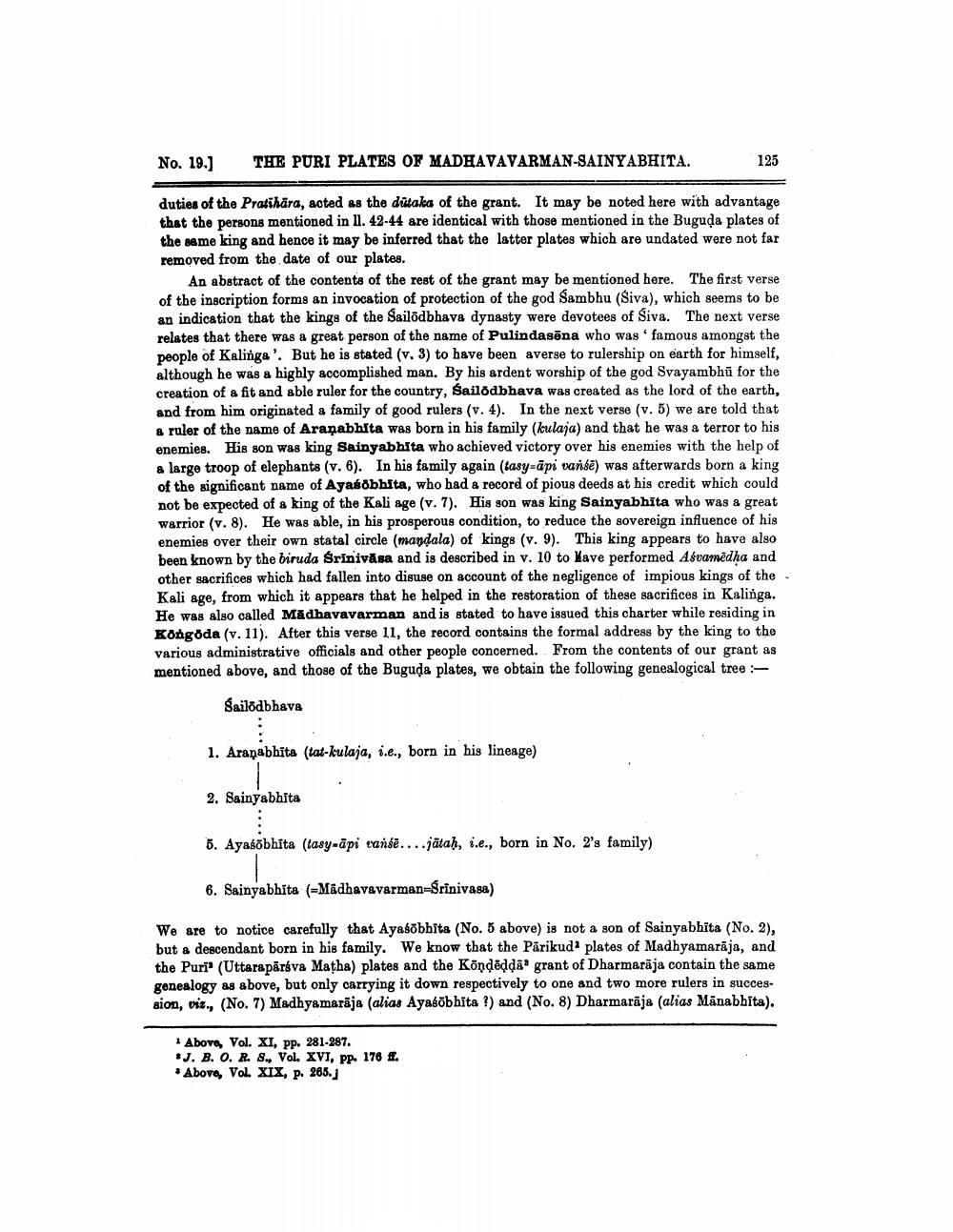________________
No. 19.)
THE PURI PLATES OF MADHAVAVARMAN-SAINYABHITA.
125
duties of the Pratihära, acted as the dutaka of the grant. It may be noted here with advantage that the persons mentioned in 11. 42-44 are identical with those mentioned in the Buguda plates of the same king and hence it may be inferred that the latter plates which are undated were not far removed from the date of our plates.
An abstract of the contents of the rest of the grant may be mentioned here. The first verse of the inscription forms an invocation of protection of the god Sambhu (Siva), which seems to be an indication that the kings of the Sailodbhava dynasty were devotees of Siva. The next verse relates that there was a great person of the name of Pulindasõna who was ' famous amongst the people of Kalinga'. But he is stated (v. 3) to have been averse to rulership on earth for himself, although he was a highly accomplished man. By his ardent worship of the god Svayambhū for the creation of a fit and able ruler for the country, Sailodbhava was created as the lord of the earth, and from him originated a family of good rulers (v. 4). In the next verse (v. 5) we are told that & ruler of the name of Araṇabhita was born in his family (kulaja) and that he was a terror to his enemies. His son was king Sainyabhita who achieved victory over his enemies with the help of a large troop of elephants (v. 6). In his family again (tasy=āpi vansē) was afterwards born a king of the significant name of Ayasobhita, who had a record of pious deeds at his credit which could not be expected of a king of the Kali age (v.7). His son was king Sainyabhita who was & great Warrior (v. 8). He was able, in his prosperous condition, to reduce the sovereign influence of his enemies over their own statal circle (mandala) of kings (v. 9). This king appears to have also been known by the biruda Srinivasa and is described in v. 10 to Wave performed Afvamëdha and other sacrifices which had fallen into disuse on account of the negligence of impious kings of the Kali age, from which it appears that he helped in the restoration of these sacrifices in Kalinga. He was also called Madhavavarman and is stated to have issued this charter while residing in Kongoda (v. 11). After this verse 11, the record contains the formal address by the king to the various administrative officials and other people concerned. From the contents of our grant as mentioned above, and those of the Buguda plates, we obtain the following genealogical tree :
Sailodbhava
1. Aranabhita (tat-kulaja, i.e., born in his lineage)
2. Sainyabhita
8. Ayasõbhita (tasy-āpi ranse....jātaḥ, i.e., born in No. 2's family)
6. Sainyabhita (Madhavavarman-Srinivasa)
We are to notice carefully that Ayasobhita (No. 5 above) is not a son of Sainyabhita (No.2), but a descendant born in his family. We know that the Pārikud plates of Madhyamarāja, and the Puri (Uttarapārsva Matha) plates and the Kõndēļdā: grant of Dharmarāja contain the same genealogy as above, but only carrying it down respectively to one and two more rulers in succession, viz., (No. 7) Madhyamarāja (alias Ayaśābhita ?) and (No. 8) Dharmarāja (alias Mänabhita).
1 Above, Vol. XI, PP. 281-287. *J. B. O. R. 8., Vol. XVI, pp. 176 4. * Abovo, Vol. XIX, p. 265.]




